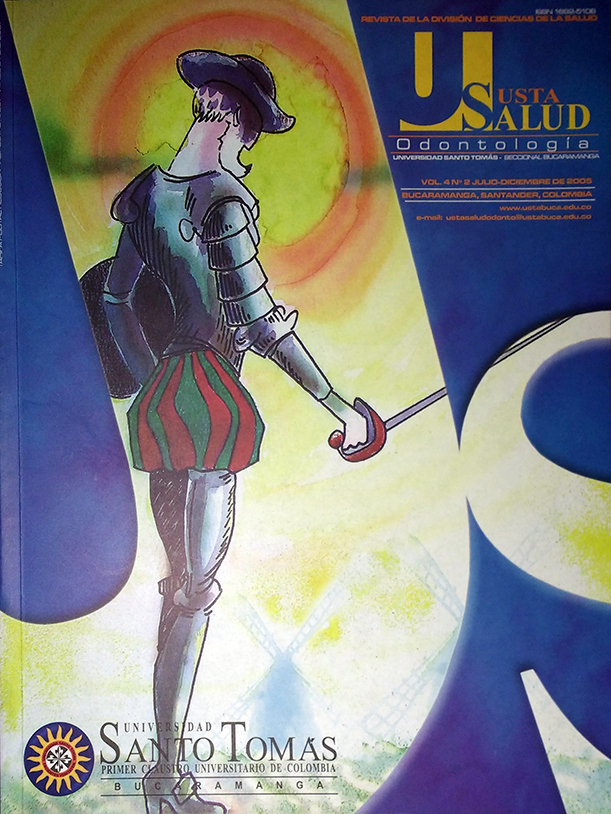DESPRENDIMIENTO DE CALOR EN LA PREPARACIÓN DE CONDUCTOS RADICULARES IN VITRO CON EL SISTEMA PROTAPER® Y LA TÉCNICA MANUAL CROWN-DOWN
Resumen
Objetivo: Medir el desprendimiento de calor a 1 y 6 mm del ápice con el sistema rotatorio ProTaper® y la técnica manual biomecánica crown-down.
Materiales y métodos: En este estudio de diseño experimental se utilizaron 52 premolares con un solo conducto, decoronados a 16 mm para ser preparados mediante la técnica manual mecánica crown-down y el sistema rotatorio ProTaper®, a temperatura del medio oral (37°C). Se emplearon termocuplas tipo K adosadas a la superficie radicular externa a 1 y 6 mm del ápice y conectadas a termómetros digitales de presición para medir la temperatura final de preparación.
Resultados: El mayor desprendimiento de calor se obtuvo con las fresas Gates Glidden # 2 y # 3 en la técnica manual mecánica crown-down, mientras que con el sistema ProTaper fueron los instrumentos F2 y F3 sin ser significativos.
Conclusiones: La técnica de preparación manual mecánica crown-down y el sistema ProTaper®, no generan variaciones de temperatura que puedan se lesivas para los tejidos perirradiculares.
[Flórez AE, Moreno DR, Jiménez JE, Serpa MF, Rojas SL, Delgado JE., Moreno GC. Desprendimiento de calor en la preparación de conductos radiculares con el sistema ProTaper® y la técnica manual crown-down. Ustasalud Odontología 2005; 4: 81 - 90 ]
Referencias
2. Tjan A., Abbate M. Temperature rise at root surface during post-space preparation. J Prosthet Dent 1993; 69: 41 - 45.
3. Ottl P, Lauer HC. Temperature response in the pulpal chamber during ultrahigh-speed tooth preparation with diamond burs of different grit. J Prosthet Dent 1998; 80:12 - 19.
4. Eriksson JH, Sundström F. Temperature rise at root surface during root canal preparation a possible cause of damage to tooth and periodontal tissue. Swed Dent J 1984; 8: 217 - 23.
5. Alarcón CM, Rojas SL, Prado M, Tabash A. Desprendimiento de calor en los sistemas rotatorios ProFile®, Kavo 29CH® y la técnica manual mecánica crown-down. Estudio in vitro. Universitas Odontológica 2003; 23: 25 - 33.
6. Penina P, Souza A. Avaliacao in vitro da variacao térnica da superficie externa da raiz durante o preparo químico-cirúrgico dos canais com o uso de instrumentos rotatórios e diferentes substancias químicas auxiliares. URL disponible en http://www.guiaodonto.com.br
7. Clauder T, Baumann M. ProTaper NT system. Dent Clin North Am 2004; 48: 87 - 111.
8. Ruddle CJ. The ProTaper endodontic system: Geometries, features, and guidelines for use. Dentistry Today 2001; 20: 60 - 67.
9. Schäfer E. Root canal instruments for manual use: A review Endod Dent Traumatol 1997; 13: 51 - 64.
10. Peters OA, Peters CI, Schönenberger K, Barbakow F. ProTaper rotary root canal preparation: assessment of torque and force in relation to canal anatomy. Int Endod J 2003; 36: 93 -99.
11. Gambarini G. Cyclic fatigue of ProFile rotary instruments after prolonged clinical use. Int Endod J 2001; 34: 386 - 389.
12. Luebke NH, Brantley WA. Torsional and metallurgical properties of rotary endodontic instruments. 2. Stainless steel Gates Glidden drills. J Endod 1991; 17: 319 - 323.
13. Luebke NH, Brantley WA. Physical dimension and torsional properties of rotary endodontic instruments. I. Gates Glidden Drills. J Endod 1990; 16: 439 - 441.
14. Leonardo MR, Leonardo RT. Sistemas rotatorios en endodoncia: Instrumentos de Níquel-Titanio. Editorial Artes Médicas 2002; Latinoamérica Pág. 53-7, 321 - 327.
15. Blum J-Y, Machtou P, Ruddle C, Micallef JP. Analysis of mechanical preparations in extracted teeth using ProTaper rotary instruments: Value of the safety quotient. J Endod 2003; 29: 567 - 575.
16. Schäfer E, Viassis M. Comparative investigation of two rotary nickel-titanium instruments: ProTaper versus RaCe. Part 1. Shaping ability in simulated curved canals. Int Endod J 2004; 37: 229 - 238.
17. Berutti E, Chiandussi G, Gaviglio I, Ibba A. Comparative analysis of torsional and bending stresses in two mathematical models of nickel-titanium rotary instruments: ProTaper versus ProFile. J Endod 2003; 29: 15 - 19.
18. Thompson SA. An overview of nickel-titanium alloys used in dentistry. Int Endod J 2000; 33: 297 -310















